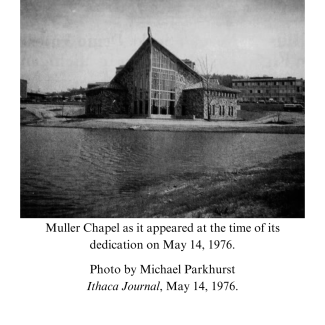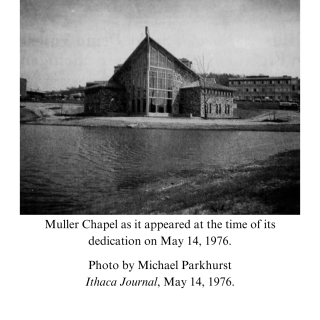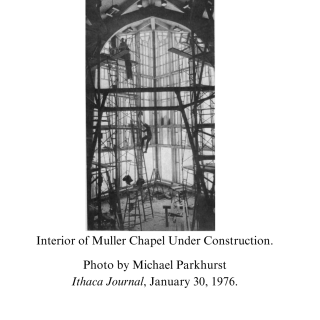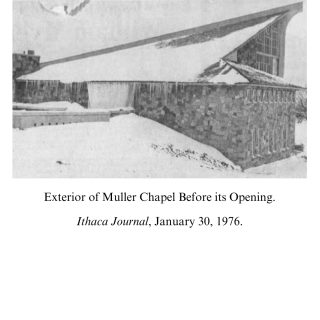Dedication
This work is dedicated to all those individuals who have endeavored to make Muller Chapel a home for spirituality and meaning-making at Ithaca College since 1976.
By Austin Reid: June 2024
The Pre-Muller Chapel Years
Ithaca College was founded on September 19, 1892, as the Ithaca Conservatory of Music when the college’s first President W. Grant Egbert organized classes for students inside four rooms rented within a house located at 403 East Seneca St. At the time there were just ten faculty members. These individuals included eight teachers and two lecturers.1 By 1894, the college’s enrollment increased resulting in the school relocating into the Wilgus Opera House at the intersection of State and Tioga streets where Center Ithaca is now found. The opera house could seat around 1,000 people and the room was located above Rothschild Brothers, a department store that served the Tompkins County community for nearly a century. The college graduated its first class in 1897, which consisted of just two students M. Ethel Nichols and Kate Green.2 In 1910 the Ithaca Conservatory began to move out of rented quarters by purchasing the Boardman House, the institution’s first owned building. This structure is still located at 120 East Buffalo St. One year prior in 1909 the Ithaca Conservatory had 12 students participate in its 17th annual commencement. It is likely that in these early years, conservatory students who chose to practice a faith found community in one of Ithaca’s downtown congregations. The campus enrollment was likely too small to support independent student organizations dedicated to religious practice. It is also known that local congregations and individual families made efforts to welcome students into faith communities. By 1930, it was a custom at the conservatory that a representative from Ithaca’s religious congregations would address students at convocation and welcome them to participate in a local religious community.3 In October 1930 Reverend Alfred Boutwell, who was associated with the First Baptist Church, welcomed new students and noted the proximity of many local congregations to the Ithaca Conservatory. He also advised that while students could avoid the various churches in town “there would be a vigorous pursuit” and he hoped each student, new and old, would find a home where they could be welcomed.4 In addition to attending religious services downtown, some students traveled to Cornell University to engage with a faith community. By 1936, it was reported by Reverend John Fetter of First Baptist Church that most congregations in Ithaca had dedicated student groups.5
During the 1930s religious groups also began to form among Ithaca College students. The first known religious organization was the Newman Club, a Catholic society. While Ithaca College students had participated in activities organized by Cornell’s Newman Club since at least 1930, and likely since that club’s formation in 1914, in 1937 an independent chapter of the Newman Club was established at Ithaca College.6 The group's first officers were Terry Ott, president, Julia Davis, vice president, William O’Neil, secretary, and Ralph Iorio, treasurer. Reverend Donald Cleary, Assistant Rector at Immaculate Conception Church in downtown Ithaca also played an instrumental role in forming the group. The Newman Club, an international organization for Catholic college students, is named in honor of John Henry Newman, a Catholic theologian and philosopher, who lived from 1801 to 1890. The Ithaca College Catholic Community, which continues to exist on Ithaca College’s campus, is a direct descendant of this Newman Club chapter. Hillel at Ithaca College can also trace its origins to the 1930s. Like their Catholic peers, Jewish students at Ithaca College who chose to engage with Jewish life benefited from a downtown congregation, Temple Beth-El. This community traces its origins to 1924 when two earlier communities, Agudath Achim and Chevra Kadisha, merged.7 In addition, some Jewish students likely elected to travel up the East Hill to Cornell to engage with coreligionists on Cornell’s campus. Cornell’s first Jewish organization, Zeta Beta Tau was established in 1907, and in 1912 the Menorah Society was formed.8 The Menorah Society was the predecessor of Hillel, an international Jewish student organization that had a presence at Cornell by 1929. Hillel is named after Rabbi Hillel the Elder, a sage who lived at the end of the first century BCE and the beginning of the first century CE. In November 1939, Rabbi David Polish helped to create a Hillel chapter at Ithaca College that was independent of the Cornell organization.9 Evelyn Teper ‘40 served as the first president of Hillel and Eleanor Kovitsky ‘42 served as Ithaca College’s representative to the national B’nai B’rith Hillel Council. Ithaca College’s Hillel organization disbanded during World War II, however, when the college’s enrollment decreased significantly as many young people were called into the service. The Newman Club, which had a much larger pool of students to draw membership from, continued its activities at Ithaca College throughout the war.
By the early 1950s, the number of religious organizations at Ithaca College began to grow once more as the college continued to experience an increase in enrollment following World War II. The first known Protestant group at Ithaca College was created in February 1952.10 Members of the organization, which adopted the name Ithaca College Christian Fellowship, were inspired by the activities of Hillel and the Newman Club.11 Early members of the fellowship included Carol Conklin, Dody Hewitt, Harold Munroe, JoAnne Deisig, John Gilmour, Joyce Fullagar, June Billings, Midge Peck, Mort Clark, Pat Myers, and Shirley Swartout.12 John Gilmour ‘52 served as the group’s first head.13 By April 1955 the group had reorganized itself as the Ithaca College Protestant Fellowship.14 Like Hillel and the Newman Club, the organization sponsored educational, religious, and social activities. In addition, by December 1954 another faith-based organization, the Canterbury Club existed at Ithaca College.15 This Episcopal student organization had strong connections to St. John's Episcopal Church on N Cayuga St. The group remained active at Ithaca College until at least January 1959.16 Hillel’s activities at Ithaca College resumed by 1946. On February 21, 1955, Jewish students at Ithaca College again established a Hillel chapter independent of Cornell’s.17 Dr. Jack Gelfand, an assistant professor in the School of Business, served as the organization's first faculty advisor. The organization’s first officers were Bob Ross, president, Marsha Bear, secretary, and Alan Berkowitz, treasurer.18
Interfaith efforts at Ithaca College also developed further during the 1950s. In 1957, The Inter-Religious Activities Council was formed.19 This is the first known interfaith group at Ithaca College and its members included representatives from the Canterbury Club, Hillel, and the Newman Club. The council grew out of Religious Emphasis Days, a joint effort organized by faculty and students to raise awareness about differences and similarities in faith practices across various religious groups on campus.20 The first officers of the organization were Carl Pirko, president, David Miller, vice president, and Betty Rupp, secretary and treasurer. One of the first activities undertaken by the council was organizing to find office space for the chaplains who engaged with Ithaca College students. While it appears that the Inter-Religious Activities Council faded by 1961, by October 1962 Ithaca College had dedicated office spaces for Reverend George Clarkson and Reverend Richard Murphy, the two campus chaplains. This space was located inside Landon House at 118 E. Court St.21 Reverend George Clarkson, the first Protestant chaplain at Ithaca College, began working part-time on campus in September 1962.22 At the time, he served as pastor of the Federated Church in Danby. This congregation was an interdenominational church. Before coming to Tompkins County, Reverend Clarkson served as a pastor at a Methodist church in Island Park, New York, and he later worked for a congregation serving the areas of Dresden and Milo near Seneca Lake.23 He was brought to Ithaca College through the efforts of the United Christian Council. This organization, which was formed in the spring of 1962, consisted of local chaplains, students, faculty, and staff. Its purpose was to unify the religious activities of six Protestant denominations and coordinate engagement with Ithaca College students.24The council was a successor to the Ithaca College Christian Fellowship. By 1965, the United Christian Council was renamed the United Christian Fellowship. Protestant religious life at Ithaca College was primarily organized under this name until at least 1988.
Reverend Richard Murphy served as a Catholic chaplain at Ithaca College beginning in 1959. In addition to his work with Ithaca College students, Reverend Murphy was also the assistant pastor at Immaculate Conception Church.25 In 1963, Reverend Robert McFiggins also began ministering to Ithaca College students. By this time, Ithaca College was two years into its move to the South Hill. As more students left downtown for the new campus, the chaplain's office also moved by October 1966 to the basement of Dorm 3.26 Three years earlier, in 1963 Rabbi Morris Goldfarb offered office hours in Dorm 5.27 Rabbi Goldfarb had served both Cornell University and Ithaca College as Jewish Chaplain since 1948.28 A prominent feature of the shared chaplain’s space in Dorm 3 was an interfaith coffee house.29 This gathering spot, which was open six days a week, was operated by students who organized under the Inter-Faith Coffee House Committee.30 The coffee house, which was named the I & E Coffee House by September 1967, soon became a leading gathering spot on campus hosting art exhibits, poetry readings, and musical performances. The coffee house, one of the first purely social spaces on campus, also served as a location for debates, lectures, and games.31 The I & E Coffee House remained in Rowland Hall, the name for Dorm 3 by September 1968, until 1971 when the location moved to Egbert Union.32 Egbert Union is now known as Egbert Hall. The I & E Coffee House was later described by Reverend Clarkson as a place of “transcendental grunge”.33 By 1968, the area was known for its artistic graffiti.34
While the space in the Rowland Hall basement provided areas for pastoral counseling and programming for nine years, by 1960 some members of Ithaca College’s Board of Trustees were already discussing the creation of a designated chapel on the South Hill campus.35 It was initially announced in April 1960 that a chapel would be opened at Ithaca College by 1966.36 Key among those individuals who advocated for the creation of a chapel was Herman E. Muller. Muller, who served as chairman of the Ithaca College Board of Trustees from 1950 until his death in 1965, became interested in funding the creation of a chapel at Ithaca College in part after learning that federal and state building grants could not be utilized for this purpose.37 Plans did not begin to be created for the chapel, however, until 1973.38 More will be written about this in the next section.




